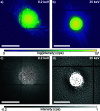Hard X-ray wavefront correction via refractive phase plates made by additive and subtractive fabrication techniques
- PMID: 32876586
- PMCID: PMC7467333
- DOI: 10.1107/S1600577520007900
Hard X-ray wavefront correction via refractive phase plates made by additive and subtractive fabrication techniques
Abstract
Modern subtractive and additive manufacturing techniques present new avenues for X-ray optics with complex shapes and patterns. Refractive phase plates acting as glasses for X-ray optics have been fabricated, and spherical aberration in refractive X-ray lenses made from beryllium has been successfully corrected. A diamond phase plate made by femtosecond laser ablation was found to improve the Strehl ratio of a lens stack with a numerical aperture (NA) of 0.88 × 10-3 at 8.2 keV from 0.1 to 0.7. A polymer phase plate made by additive printing achieved an increase in the Strehl ratio of a lens stack at 35 keV with NA of 0.18 × 10-3 from 0.15 to 0.89, demonstrating diffraction-limited nanofocusing at high X-ray energies.
Keywords: aberration correction; phase plate; ptychography; refractive X-ray optics.
open access.
Figures









References
-
- Alianelli, L., Sawhney, K. J. S., Malik, A., Fox, O. J. L., May, P. W., Stevens, R., Loader, I. M. & Wilson, M. C. (2010). J. Appl. Phys. 108, 123107.
-
- Antipov, S., Assoufid, L., Grizolli, W., Qian, J. & Shi, X. (2018). Proceedings of the 9th International Particle Accelerator Conference (IPAC’18), 29 April–4 May 2018, Vancouver, BC, Canada, pp. 4057–4058. THPMF011.
-
- Bernert, C., Hoppe, R., Wittwer, F., Woike, T. & Schroer, C. G. (2017). Opt. Express, 25, 31640. - PubMed
LinkOut - more resources
Full Text Sources
Other Literature Sources

